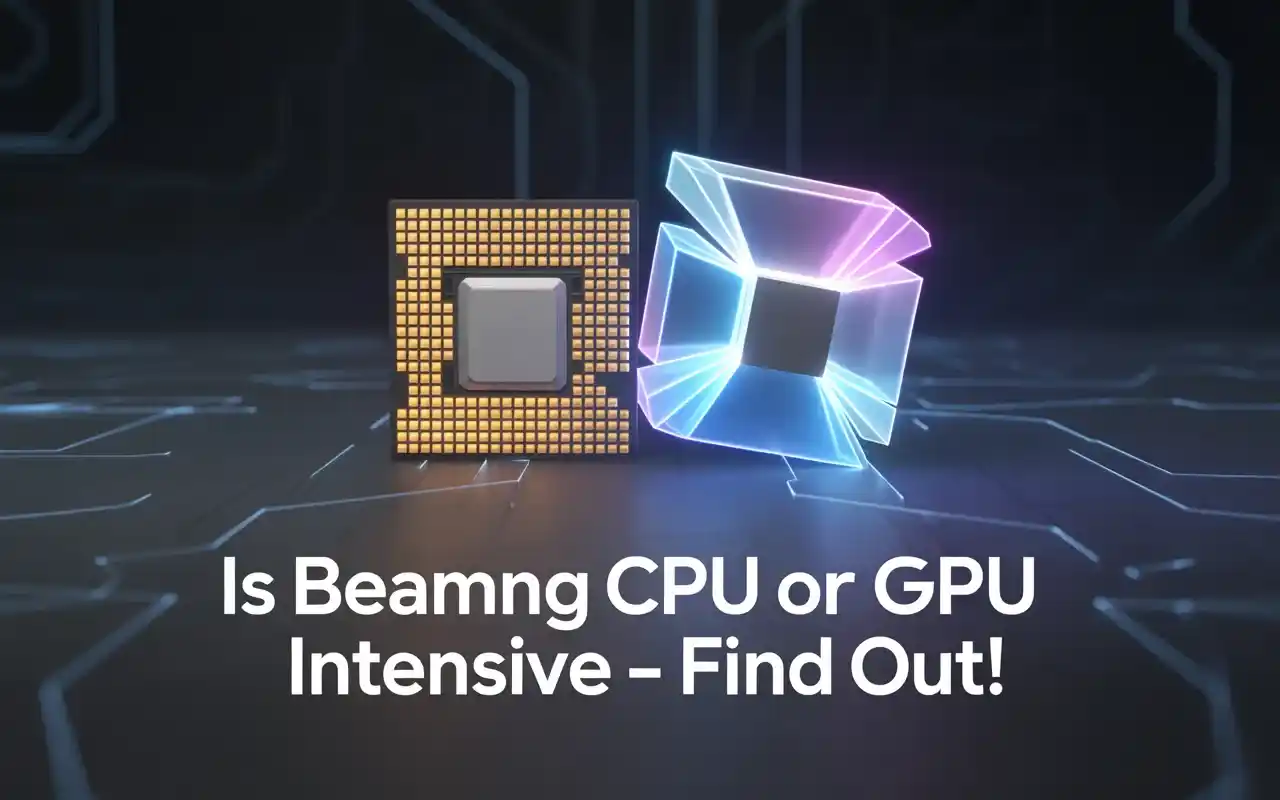BeamNG is mostly CPU-intensive. Its soft-body physics need a strong processor to run smoothly. Even with a powerful GPU, a weak CPU can cause lag. For better performance, focus on your CPU first. GPU helps with visuals, but gameplay speed and realism depend more on the CPU in BeamNG.
In this guide, we’ll explain whether BeamNG is CPU or GPU-intensive, and how you can get the best performance without wasting money on the wrong upgrade.
What Makes BeamNG Demanding on PC Hardware
BeamNG is heavy because it uses real-time soft-body physics. Every crash, bend, and car part is calculated live. This needs strong CPU power and decent GPU visuals. If your PC is weak, the game will lag badly, especially in fast or crash-heavy moments.
Is BeamNG More CPU-Heavy Than GPU?
Yes, BeamNG depends more on the CPU than the GPU. It does thousands of physics calculations each second. A powerful graphics card helps visuals, but can’t make up for a slow processor. So, CPU strength matters more for performance in this game.
Why BeamNG’s Physics Engine Depends on CPU
BeamNG simulates car crashes, damage, and motion in real time, and all that is handled by the CPU. The GPU just renders visuals. If your CPU isn’t strong, the game will stutter and physics won’t run smoothly — even with a high-end graphics card.
Also Read:Where to Find GPU in Device Manager
How GPU Affects Visual Quality in BeamNG
GPU controls how good BeamNG looks — resolution, shadows, textures, and effects. But visuals alone won’t make the game run better. That’s the CPU’s job. So yes, a strong GPU makes BeamNG beautiful, but not faster. Gameplay depends on the processor.
BeamNG CPU vs GPU Load During Gameplay
| Task | CPU Load | GPU Load |
| Physics Calculations | High | Low |
| Car Crashes/Movement | High | Medium |
| Visuals/Textures | Low | High |
| Lighting/Resolution | Low | High |
BeamNG leans more on the CPU than the GPU, especially during simulations.
Does BeamNG Use Multiple CPU Cores?

Yes, BeamNG supports multi-core CPUs, but it still relies more on single-core performance. That means one strong core does most of the work. A CPU with fast individual cores will perform better than a slow CPU with many weak ones.
How Important is Single-Core Speed for BeamNG?
Very important. BeamNG runs many key tasks on a single thread, so faster single-core speed gives smoother gameplay. Even a multi-core CPU will struggle if its cores are slow. One powerful core matters more than multiple average ones here.
Can a Good GPU Compensate for a Weak CPU?
No. A powerful GPU only improves graphics, not performance. BeamNG’s heavy physics calculations depend on the CPU. So even if your graphics look amazing, a weak processor will still cause lag, crashes, or stutter during gameplay or car collisions.
Real-World Performance: CPU vs GPU in BeamNG

Real players report big FPS boosts when upgrading CPUs. Going from Intel i3 to i7, or Ryzen 3 to Ryzen 7, gives smoother gameplay. GPU upgrades help only if the CPU is already fast. In BeamNG, CPU first — GPU second.
Also Read:What is the difference between a GPU and a CPU
Minimum and Recommended Specs for BeamNG
| Component | Minimum | Recommended |
| CPU | Dual-core @ 3.0GHz | Quad-core @ 3.5GHz+ |
| GPU | GTX 550 Ti | GTX 970 / RX 580 |
| RAM | 8 GB | 16 GB |
| Storage | 20 GB HDD | SSD preferred |
Tip: Upgrade the CPU first to enjoy smooth crashes and simulation.
Signs Your CPU Is Struggling in BeamNG
- Game stutters in crowded scenes
- FPS drops during crashes
- CPU usage stays at 100%
- Delayed controls or glitches
- PC heats up quickly during play.
These signs show your processor can’t handle BeamNG’s demands.
Tips to Optimize BeamNG for Better Performance
- Lower physics detail settings
- Use low dynamic reflection.s
- Close background apps
- Install the game on an SSD
- Keep drivers up to date.
- Use Windows performance mode.
- Monitor CPU temperatures
But the best performance boost comes from a stronger CPU.
CPU or GPU — What Should You Upgrade First?
Always upgrade your CPU first. BeamNG is physics-heavy, and your processor handles that. A decent GPU is enough for good visuals, but lag and crashes come from CPU limitations. For smooth and realistic driving, CPU power matters the most.
FAQs
1. Is BeamNG harder on laptops than desktops?
Yes. Desktops have stronger CPUs and better cooling, so BeamNG runs smoother on them.
2. Can BeamNG run without a dedicated GPU?
Yes, but it will lag heavily. Integrated graphics can’t handle the visuals or physics well.
3. Does BeamNG push CPU temps high?
Yes, the CPU gets hot fast due to continuous physics calculations during gameplay.
4. Is BeamNG good for budget PCs?
Not really. Budget PCs may struggle even on low settings unless the CPU is fast.
5. Do you need a high-end GPU for BeamNG?
No. A mid-range GPU is fine if your CPU is strong. CPU is more important than GPU.
Conclusion
BeamNG is mostly CPU-heavy because of its detailed crash physics. A strong processor gives smoother gameplay, while the GPU handles visuals. If your game lags or stutters, it’s likely your CPU. For better performance in BeamNG, always upgrade the CPU first, not the GPU. That’s what makes the real difference in this game.

